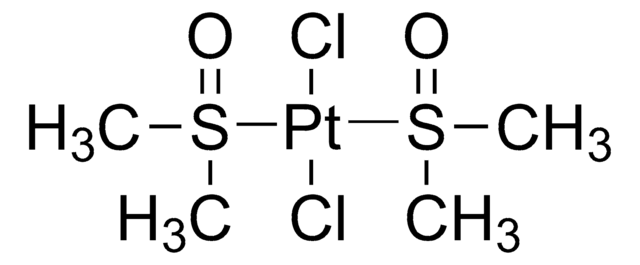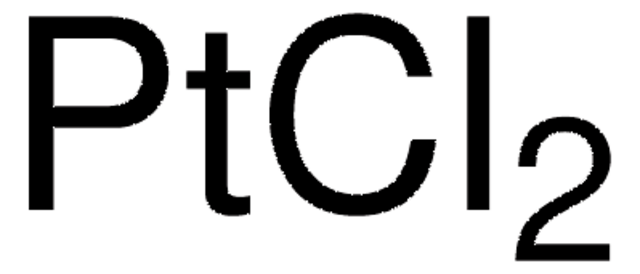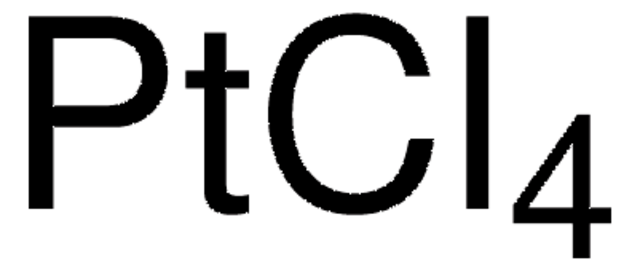520853
Potassium tetrachloroplatinate(II)
≥99.9% trace metals basis
Sinonimo/i:
Potassium platinum(II) chloride
About This Item
Prodotti consigliati
Saggio
≥99.9% trace metals basis
Forma fisica
powder or crystals
Composizione
Pt, ≥46.2%
Impurezze
≤1000.0 ppm Trace Metal Analysis
Densità
3.38 g/mL at 25 °C (lit.)
Stringa SMILE
[K+].[K+].Cl[Pt--](Cl)(Cl)Cl
InChI
1S/4ClH.2K.Pt/h4*1H;;;/q;;;;2*+1;+2/p-4
RVRDLMCWUILSAH-UHFFFAOYSA-J
Cerchi prodotti simili? Visita Guida al confronto tra prodotti
Descrizione generale
Applicazioni
- As a precursor to prepare platinum nanoparticles and mesoporous platinum nanospheres with tunable pore sizes.
- As a catalyst for selective methane oxidation through C-H activation. In addition, to synthesize octahedral Pd@Pt1.8Ni nanocrystals with an ultrathin PtNi alloy shell. The nanocrystals exhibited better ORR activity and durability than the commercial Pt/C for fuel cells.
- To prepare Pt atomic clusters were synthesized using a one-step carbon-defect-driven electroless deposition method. These catalysts demonstrated low overpotential, high activity for the hydrogen evolution reaction, exceptional stability, and improved utilization efficiency of Pt. The Pt-AC/DG (Atomic Clusters/Defective Graphene) cathode showed excellent hydrogen production activity, remarkable stability, and significantly reduced Pt usage compared to the Pt/C catalyst.
- As a starting material to synthesize cyclometalated platinum(II) complexes with long-lived luminescence in solution.
Caratteristiche e vantaggi
Avvertenze
Danger
Indicazioni di pericolo
Consigli di prudenza
Classi di pericolo
Acute Tox. 3 Oral - Eye Dam. 1 - Resp. Sens. 1 - Skin Irrit. 2 - Skin Sens. 1
Codice della classe di stoccaggio
6.1C - Combustible acute toxic Cat.3 / toxic compounds or compounds which causing chronic effects
Classe di pericolosità dell'acqua (WGK)
WGK 1
Punto d’infiammabilità (°F)
Not applicable
Punto d’infiammabilità (°C)
Not applicable
Dispositivi di protezione individuale
Eyeshields, Faceshields, Gloves, type P2 (EN 143) respirator cartridges
Certificati d'analisi (COA)
Cerca il Certificati d'analisi (COA) digitando il numero di lotto/batch corrispondente. I numeri di lotto o di batch sono stampati sull'etichetta dei prodotti dopo la parola ‘Lotto’ o ‘Batch’.
Possiedi già questo prodotto?
I documenti relativi ai prodotti acquistati recentemente sono disponibili nell’Archivio dei documenti.
I clienti hanno visto anche
Il team dei nostri ricercatori vanta grande esperienza in tutte le aree della ricerca quali Life Science, scienza dei materiali, sintesi chimica, cromatografia, discipline analitiche, ecc..
Contatta l'Assistenza Tecnica.














